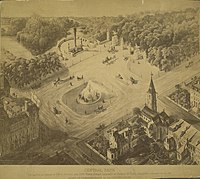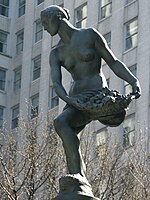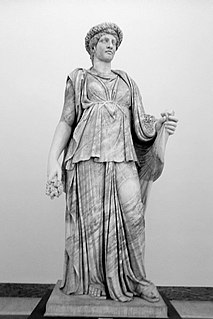
Pomona was a goddess of fruitful abundance in ancient Roman religion and myth. Her name comes from the Latin word pomum, "fruit", specifically orchard fruit.
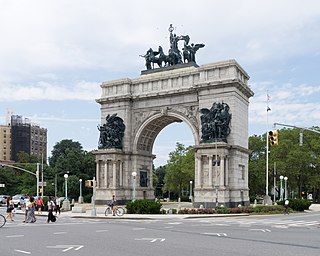
Grand Army Plaza, originally known as Prospect Park Plaza, is a public plaza that comprises the northern corner and the main entrance of Prospect Park in the New York City borough of Brooklyn. It consists of concentric oval rings arranged as streets, with the namesake Plaza Street comprising the outer ring. The inner ring is arranged as an ovoid roadway that carries the main street – Flatbush Avenue – with eight radial roads connecting Vanderbilt Avenue; Butler Place; two separate sections of Saint John's Place; Lincoln Place; Eastern Parkway; Prospect Park West; Union Street; and Berkeley Place. The only streets that penetrate to the inner ring are Flatbush Avenue, Vanderbilt Avenue, Prospect Park West, Eastern Parkway, and Union Street.

The American Renaissance was a period of American architecture and the arts from 1876 to 1917, characterized by renewed national self-confidence and a feeling that the United States was the heir to Greek democracy, Roman law, and Renaissance humanism. The era spans the period between the Centennial Exposition and the United States' entry into World War I.

The Wisconsin State Capitol, located in Madison, Wisconsin, houses both chambers of the Wisconsin legislature along with the Wisconsin Supreme Court and the Office of the Governor. Completed in 1917, the building is the fifth to serve as the Wisconsin capitol since the first territorial legislature convened in 1836 and the third building since Wisconsin was granted statehood in 1848. The Wisconsin State Capitol is the tallest building in Madison, a distinction that has been preserved by legislation that prohibits buildings taller than the columns surrounding the dome. The Capitol is located at the southwestern end of the Madison Isthmus. The streets surrounding the building form the Capitol Square, which is home to many restaurants and shops.

Karl Theodore Francis Bitter was an Austrian-born American sculptor best known for his architectural sculpture, memorials and residential work.

Audrey Marie Munson was an American artist's model and film actress, today considered "America's first supermodel." In her time, she was variously known as "Miss Manhattan", the "Panama–Pacific Girl", the "Exposition Girl" and "American Venus." She was the model or inspiration for more than twelve statues in New York City, and many others elsewhere. Munson also appeared in four silent films, including Inspiration (1915) in which she appeared nude, one of the first American actresses to do so in a non-pornographic film.
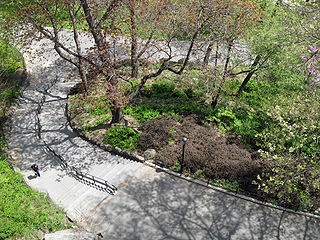
Morningside Park is a 30-acre (12-hectare) public park in Upper Manhattan, New York City. The park is bounded by 110th Street to the south, 123rd Street to the north, Morningside Avenue to the east, and Morningside Drive to the west. A cliff made of Manhattan schist runs through the park and separates Morningside Heights, above the cliff to the west, from Harlem. The park includes other rock outcroppings; a man-made ornamental pond and waterfall; three sculptures; several athletic fields; playgrounds; and an arboretum. Morningside Park is operated by the New York City Department of Parks and Recreation, although the group Friends of Morningside Park helps maintain it.

The Gorham Manufacturing Company is one of the largest American manufacturers of sterling and silverplate and a foundry for bronze sculpture.

Isidore Konti was a Vienna-born sculptor. He began formal art studies at the age of 16 when he entered the Imperial Academy in Vienna, where he studied under Edmund von Hellmer. In 1886, he won a scholarship that allowed him to study in Rome for two years. While there he developed a love of Renaissance art that was to affect the nature of his mature sculpture. Upon returning to Austria, Konti worked as an architectural modeler.

Bethesda Terrace and Fountain are two architectural features overlooking the southern shore of the Lake in New York City's Central Park. The fountain, with its Angel of the Waters statue, is located in the center of the terrace.

Fountain of Time, or simply Time, is a sculpture by Lorado Taft, measuring 126 feet 10 inches (38.66 m) in length, situated at the western edge of the Midway Plaisance within Washington Park in Chicago, Illinois, in the United States. The sculpture is inspired by Henry Austin Dobson's poem "Paradox of Time". Its 100 figures passing before Father Time were created as a monument to the 100 years of peace between the United States and the United Kingdom following the Treaty of Ghent in 1814. Father Time faces the 100 from across a water basin. The fountain's water was turned on in 1920, and the sculpture was dedicated in 1922. It is a contributing structure to the Washington Park United States Registered Historic District, which is a National Register of Historic Places listing.

Doris Doscher was an American actress and model who appeared in the movie The Birth of a Race (1915), playing the role of "Eve." She posed as Liberty for the Standing Liberty quarter (1916–1930) by Hermon Atkins MacNeil. She was also the model for the Pulitzer Fountain of Abundance by Karl Bitter in front of the Plaza Hotel in New York City.

Burt William Johnson was an American sculptor.

Grand Army Plaza is a square at the southeast corner of Central Park in Manhattan, New York City, at the intersection of Fifth Avenue and Central Park South, covering two blocks on the west side of Fifth Avenue between 58th and 60th Streets. It contains an equestrian statue of William Tecumseh Sherman on its northern half and the Pulitzer Fountain on its southern half.
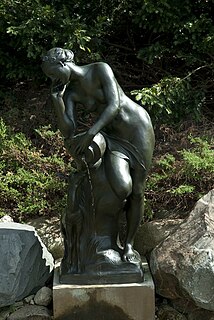
Nymph and Fawn is a public artwork by American artist Isidore Konti and located within the Oldfields–Lilly House & Gardens estate on the grounds of the Indianapolis Museum of Art (IMA), near Indianapolis, Indiana. Created in 1917, the bronze sculpture is also a working fountain. It portrays a female nude pouring water from an urn while standing beside a small fawn.
Ferdinand Schevill (1868–1954) was an American historian.

William Tecumseh Sherman, also known as the Sherman Memorial or Sherman Monument, is a sculpture group honoring William Tecumseh Sherman, created by Augustus Saint-Gaudens and located at Grand Army Plaza in Manhattan, New York. Cast in 1902 and dedicated on May 30, 1903, the gilded-bronze monument consists of an equestrian statue of Sherman and an accompanying statue, Victory, an allegorical female figure of the Greek goddess Nike. The statues are set on a Stony Creek granite pedestal designed by the architect Charles Follen McKim.

Fountain of the Centaurs is a fountain located on the grounds of the Missouri State Capitol in Jefferson City, Missouri, north of the Capitol building.

Thomas Jefferson is a 1911 bronze statue of a seated Thomas Jefferson created by Karl Bitter for the Cuyahoga County Courthouse in Cleveland, Ohio, United States.

The Yavapai County Courthouse is located at 120 South Cortez Street in Prescott, Arizona. The current courthouse building was built in 1916. It was designed by architect William N. Bowman (1868–1944) and it was added to the National Register of Historic Places in 1977. It is also known for its statue of Bucky O'Neill, a Rough Rider and former Mayor of Prescott. Arizona Senator Barry Goldwater announced his presidential candidacy in 1964 from the steps of the courthouse.




